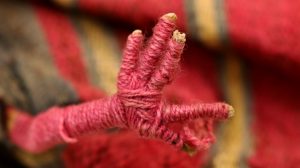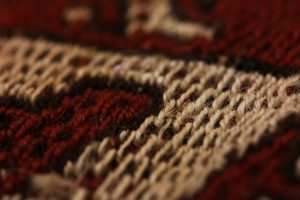This is a guest post by Rosemary Ryan, an archaeological research fellow at the Library. She is a student at Towson University specializing in forensic anthropology and archaeology. Her research at the Library supports the “Exploring the Early Americas” exhibit and the Jay I. Kislak Collection, made up of more than 3,000 items related to early American history dating to the Pre-Columbian era.
Rosemary Ryan (left) and Tana Villafana of the Library’s Preservation Research and Testing Division examine dolls from the Ginsberg collection woven by the Nazcas, a Pre-Columbian Peruvian culture. Photo by Shawn Miller.
I love it when an archaeologist decides to lay down her tools, ascend out of the trench and venture into the public domain to talk about her current work, why she is doing it and the kinds of dilemmas she’s encountered along the way. Ordinarily, researchers save this chattering for presentations at their local archaeological association. The reality is that very little of this information makes it to print. But having the opportunity to work alongside curator John Hessler in the Library’s Geography and Map Division has not only been a happy accident, but allowed my curious voice to be heard.
There is quite an array of projects currently underway, but the most pertinent and challenging, due to its sheer size, is the recently acquired collection graciously donated by William and Inger Ginsberg, long-time members of the Library’s James Madison Council. The collection is comprised of 28 individual Peruvian Pre-Columbian textiles, including cocoa-carrying bags called Chuspas and burial dolls.
These artifacts are rare partly because of their condition – all the items acquired have been remarkably preserved due to the accidental coincidence of two circumstances: dry, arid climate and worship of the dead. But they are also exceptional examples epitomizing regional techniques and the cultural importance of a bygone era.

Right hand of a burial doll, 900–1400 A.D. Photo by Rosemary Ryan.
As part of a universal practice among ancient Peruvian cultures, the dead were buried with garments reflecting their social status, cultural identity or religion. In cases where textiles are found in their original sites, particularly from civilizations that we know little about, garments and accessories can provide influential evidence for understanding different group identities and social structure.
A conundrum faces us, however, with the Ginsberg collection: we do not know the provenance of many of the items, meaning we don’t know the specific archaeological sites from which they came.
My ongoing work at the Library has been to uncover as much as possible about these enigmatic items. In reality, we possess only two ambiguously broad pieces to this puzzle. First, we know the items are Peruvian due to the exhibited designs; second, we know that they are Pre-Columbian (from before 1492). Before the Library acquired the collection, each item had been designated with a speculative description in terms of age and relative culture by dealers and collectors. So how to proceed?

Close-up of the weaving technique used for a Chuspa from the southern coastal region of Peru, 1000–1400 A.D.
More often than not, we are faced with the reality that there simply is not a lot of information to work with. Undertaking the daunting task of sifting through field notes, journals and books is not exceptionally exciting, and one has to be prepared to discover nothing. Finding a needle in a haystack couldn’t be more applicable, but postponed pleasures are always the sweetest. Not only does it satisfy and fuel all the work you’re putting forth, but it also gives a sense of accomplishment that you’re able to educate the public.
As a self-declared modern-day sleuth and forensic anthropologist, I knew zilch about textiles. I understood that the only method of understanding these items was to start with the basics, instituting my motto: learning by repetition in variation.
I started obsessively studying weaving techniques, reading any material I could lay my hands on and networking with anyone knowledgeable about the craft. The next step was to get to know the artifacts on an intimate level. This meant spending hours unraveling the nuances of each unique weave, making note of the technique, design and coloration utilized. My thought process began to change the more time I spent with the collection. The longer I looked at the handmade textiles, the initial façade of a pretty object faded and I started to put myself in the environment of its designer. Slowly, I saw myself preparing the fibers for the yarn, spending hours at the loom, and influencing the alchemy at the dye basins. I began to appreciate the evolution that went into creating that object and to understand all the decisions where one path was chosen over another.

Examples of textiles from the Ginsberg collection.
As an archaeologist, I am constantly trying to retrace those paths, to see and understand those moments when a decision had to be made and why. The whys, for an archaeologist, are how we learn about the culture in the obscure past. By looking at the past, we can see when and why spinning one kind of fiber was chosen over another, what changes occurred that led to that judgement and what the consequences of that decision were. Best of all, we can take what we learned from those ancient decisions and apply that knowledge to the same techniques that used today.
So far, as a result of our work on the Ginsberg collection, we have identified the provenance of some of the textiles. I look forward in coming months to continuing my work and learning more from from those ancient weavers of long ago.

















